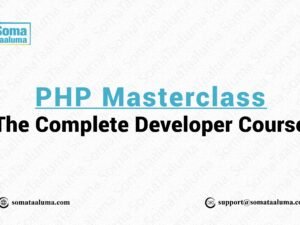MySQL Mastery: From Fundamentals to Advanced Queries
- Description
- Curriculum
- Reviews
MySQL Mastery: From Fundamentals to Advanced Queries
Unlock your potential as a database expert with our comprehensive MySQL course. Whether you’re a beginner or an aspiring database professional, this course will take you through everything you need to know to design, manage, and query databases using MySQL. Taught in Kiswahili, our hands-on training with MySQL Workbench ensures that you learn by doing, from installation to advanced query writing.
This course covers:
- Setting up MySQL Workbench and creating your first database
- Writing and executing basic SQL queries (SELECT, INSERT, UPDATE, DELETE)
- Mastering advanced techniques like JOINs, indexing, and optimizing database performance
- Building real-world databases and understanding data normalization
By the end of this course, you will be able to confidently create and manage databases, write complex queries, and solve real-world problems using MySQL. Perfect for aspiring database administrators, developers, or anyone looking to enhance their data management skills.
Why Learn MySQL?
MySQL is one of the most popular and widely used database management systems, making it an essential skill for software developers, data analysts, and IT professionals. Whether you’re building websites, apps, or handling data for business operations, MySQL is key to efficiently managing and querying data.
Start today and take your database skills to the next level with MySQL Mastery!
-
1Lesson 1: DatabasePreview 9 min & 16 sec.
Introduction to databases, creating, using and deleting your database in MySQL.
-
2Lesson 2: TablePreview 17 min & 31 sec.This lesson is locked because you haven't completed the previous one yet. Finish the previous lesson to unlock this one.
Understanding tables: structure, creation, and managing table attributes.
-
3Lesson 3: Rows Insert11 min & 39 sec.This lesson is locked because you haven't completed the previous one yet. Finish the previous lesson to unlock this one.
Inserting data into tables using SQL INSERT statements.
-
4Lesson 4: Rows Select5 min & 34 sec.This lesson is locked because you haven't completed the previous one yet. Finish the previous lesson to unlock this one.
Querying data using SQL
SELECTto retrieve specific rows from a table. -
5Lesson 5: Rows Update and Delete Records10 min & 52 sec.This lesson is locked because you haven't completed the previous one yet. Finish the previous lesson to unlock this one.
Updating and deleting records using
UPDATEandDELETEstatements. -
6Lesson 6: Autocommit, Commit, and Rollback7 min & 16 sec.This lesson is locked because you haven't completed the previous one yet. Finish the previous lesson to unlock this one.
Understanding transactions: how to use
AUTO_COMMIT,COMMIT, andROLLBACKfor data integrity. -
7Lesson 7: Time, Date & Datetime6 min & 40 secThis lesson is locked because you haven't completed the previous one yet. Finish the previous lesson to unlock this one.
Working with MySQL data types for handling time, date, and datetime fields.
-
8Lesson 8: Unique Constraint5 min & 28 sec.This lesson is locked because you haven't completed the previous one yet. Finish the previous lesson to unlock this one.
Applying the
UNIQUEconstraint to ensure that values in a column are distinct. -
9Lesson 9: Not Null Constraint6 min & 23 sec.This lesson is locked because you haven't completed the previous one yet. Finish the previous lesson to unlock this one.
Using the
NOT NULLconstraint to ensure that a column does not accept NULL values. -
10Lesson 10: Check ConstraintVideo lessonThis lesson is locked because you haven't completed the previous one yet. Finish the previous lesson to unlock this one.
Implementing the
CHECKconstraint to enforce domain integrity. -
11Lesson 11: Default Constraint8 min & 27 sec.This lesson is locked because you haven't completed the previous one yet. Finish the previous lesson to unlock this one.
Setting default values for columns using the
DEFAULTconstraint. -
12Lesson 12: Primary Key Constraint6 min & 17 sec.This lesson is locked because you haven't completed the previous one yet. Finish the previous lesson to unlock this one.
Understanding and applying the
PRIMARY KEYconstraint for unique identification of records. -
13Lesson 13: Auto Increment Attribute7 min & 28 secThis lesson is locked because you haven't completed the previous one yet. Finish the previous lesson to unlock this one.
Using
AUTO_INCREMENTto automatically generate unique IDs for new records. -
14Lesson 14: Foreign Key Constraint7 min 31 secThis lesson is locked because you haven't completed the previous one yet. Finish the previous lesson to unlock this one.
Understanding and working with foreign keys to establish relationships between tables.
-
15Lesson 15: Joins9 min & 51 sec.This lesson is locked because you haven't completed the previous one yet. Finish the previous lesson to unlock this one.
Introduction to different types of joins (INNER, LEFT, RIGHT, FULL OUTER JOIN) to combine data from multiple tables.
-
16Lesson 16: Functions8 min & 52 secThis lesson is locked because you haven't completed the previous one yet. Finish the previous lesson to unlock this one.
Using SQL functions for string manipulation, data transformation, and aggregation.
-
17Lesson 17: Logical Operators10 min & 56 secThis lesson is locked because you haven't completed the previous one yet. Finish the previous lesson to unlock this one.
Applying logical operators like AND, OR, and NOT in queries.
-
18Lesson 18: Wild Card Characters5 min & 10 sec.This lesson is locked because you haven't completed the previous one yet. Finish the previous lesson to unlock this one.
Using
LIKEand wildcards (%,_) for pattern matching inSELECTqueries. -
19Lesson 19: Order By Clause4 min & 11 secThis lesson is locked because you haven't completed the previous one yet. Finish the previous lesson to unlock this one.
Sorting query results with the
ORDER BYclause based on one or more columns. -
20Lesson 20: Limit Clause2 min & 27 secThis lesson is locked because you haven't completed the previous one yet. Finish the previous lesson to unlock this one.
Restricting the number of records retrieved using the
LIMITclause. -
21Lesson 21: Union Operator5 min & 25 sec.This lesson is locked because you haven't completed the previous one yet. Finish the previous lesson to unlock this one.
Using the
UNIONoperator to combine the results of multiple queries. -
22Lesson 22: Self Join5 min % 44 sec.This lesson is locked because you haven't completed the previous one yet. Finish the previous lesson to unlock this one.
Understanding and implementing a self-join to combine rows from the same table.
-
23Lesson 23: Views8 min & 30 sec.This lesson is locked because you haven't completed the previous one yet. Finish the previous lesson to unlock this one.
Creating and managing views to simplify complex queries and improve security.
-
24Lesson 24: Index10 min & 47 sec.This lesson is locked because you haven't completed the previous one yet. Finish the previous lesson to unlock this one.
Introduction to indexing and how it helps speed up database queries.
-
25Lesson 25: Subquery3 min & 50 sec.This lesson is locked because you haven't completed the previous one yet. Finish the previous lesson to unlock this one.
Using subqueries to perform queries within queries and return results.
-
26Lesson 26: Group By4 min & 15 sec.This lesson is locked because you haven't completed the previous one yet. Finish the previous lesson to unlock this one.
Aggregating data using the
GROUP BYclause for summarizing large datasets. -
27Lesson 27: Rollup3 min & 28 sec.This lesson is locked because you haven't completed the previous one yet. Finish the previous lesson to unlock this one.
Understanding and using the
ROLLUPoperator to create summary reports from grouped data.
-
28Lesson 28: On Delete10 min & 43 sec.This lesson is locked because you haven't completed the previous one yet. Finish the previous lesson to unlock this one.
Handling foreign key deletions using
ON DELETEactions such asCASCADE,SET NULL, etc. -
29Lesson 29: Stored Procedure10 min & 18 sec.This lesson is locked because you haven't completed the previous one yet. Finish the previous lesson to unlock this one.
Creating and using stored procedures for reusable code and efficient querying.
-
30Lesson 30: Trigger10 min & 48 sec.This lesson is locked because you haven't completed the previous one yet. Finish the previous lesson to unlock this one.
Implementing triggers to automatically perform actions in response to data modifications.
-
31Lesson 31: First Normal Form (1NF)Video lessonThis lesson is locked because you haven't completed the previous one yet. Finish the previous lesson to unlock this one.
-
32Lesson 32: Second Normal Form (2NF)Video lessonThis lesson is locked because you haven't completed the previous one yet. Finish the previous lesson to unlock this one.
-
33Lesson 33: Third Normal Form (3NF)Video lessonThis lesson is locked because you haven't completed the previous one yet. Finish the previous lesson to unlock this one.

The entire course is taught in Kiswahili.
- Basic knowledge of computers and the internet
- Familiarity with general programming concepts (optional but helpful)
- No prior experience with MySQL required
- A computer with internet access
- MySQL Workbench installed (installation will be guided step-by-step, and students will install it themselves)
- Enthusiasm to learn and explore database management concepts!
- Aspiring Database Administrators
- Beginner to Intermediate Learners in IT and Computer Science
- Web Developers interested in improving database skills
- Individuals looking to manage or optimize databases
- Students in technology and software development programs
- Entrepreneurs who want to manage their own data systems
- Anyone interested in mastering MySQL for career advancement






